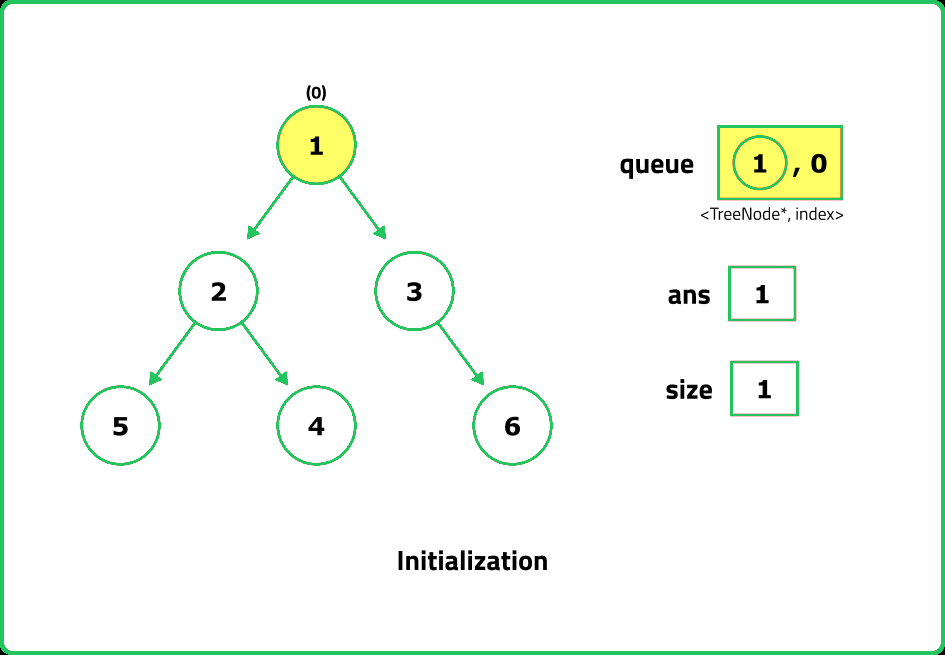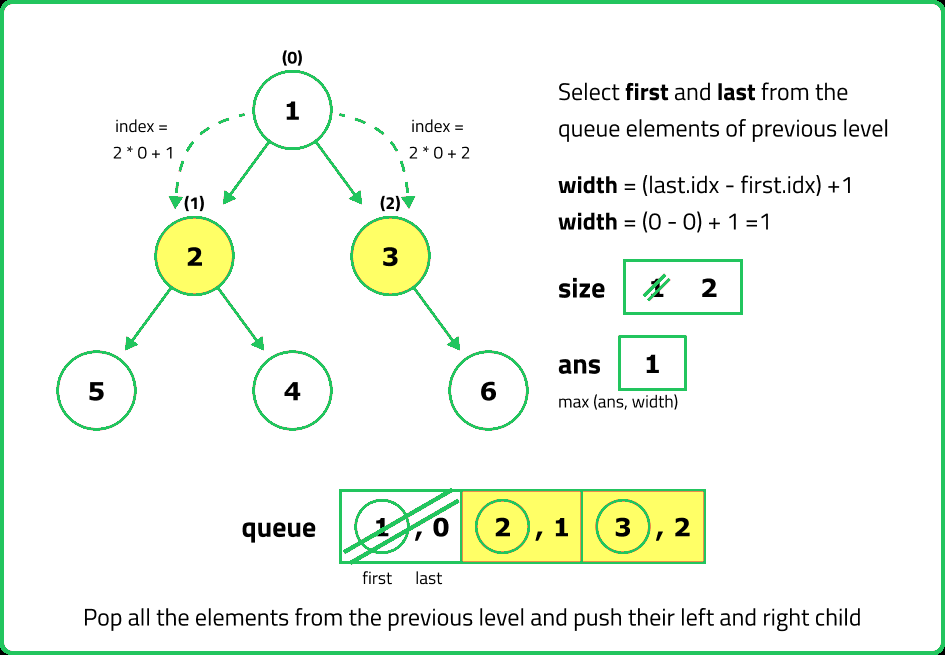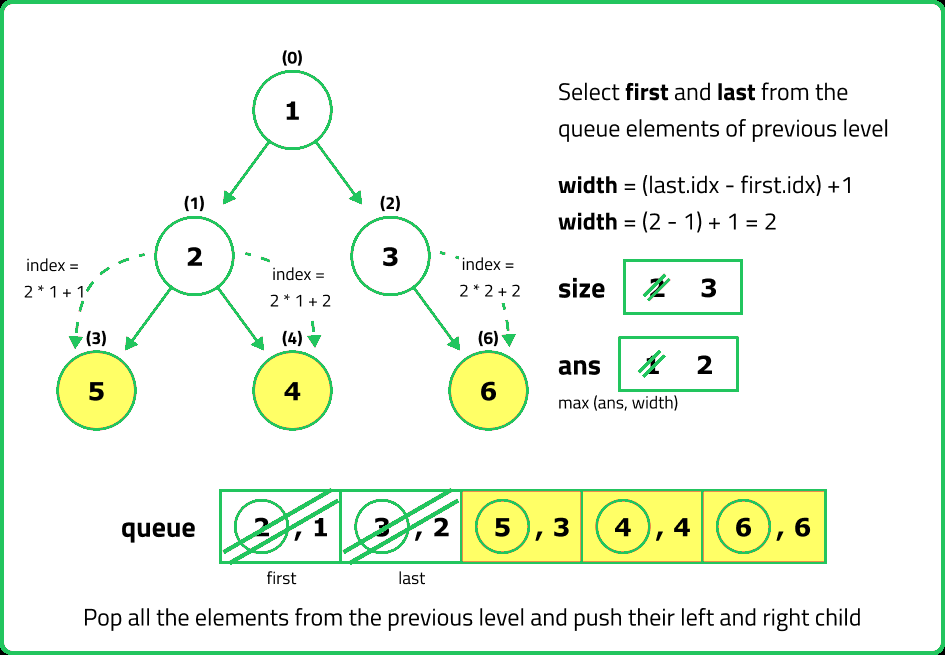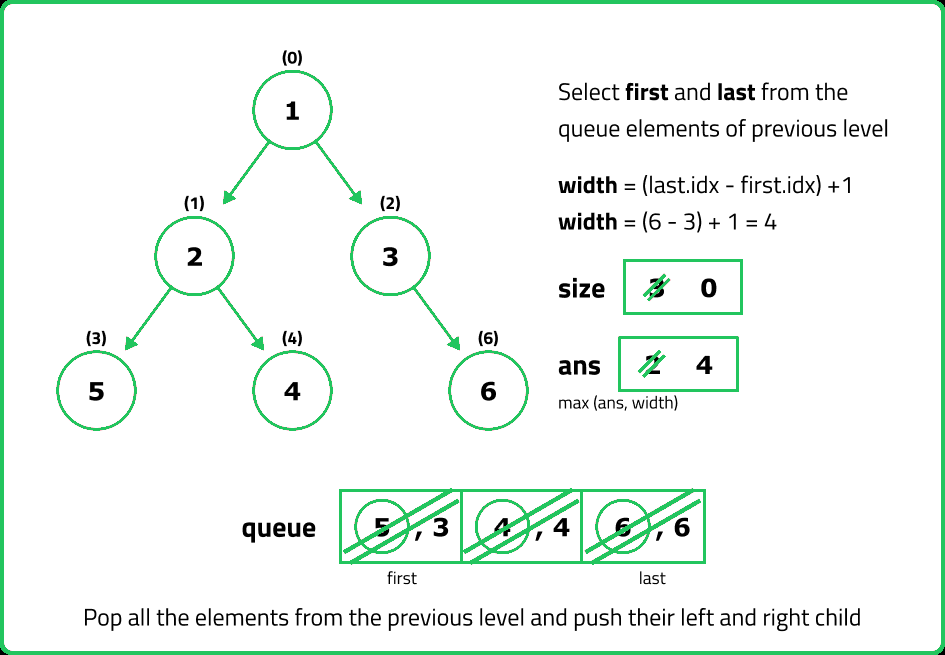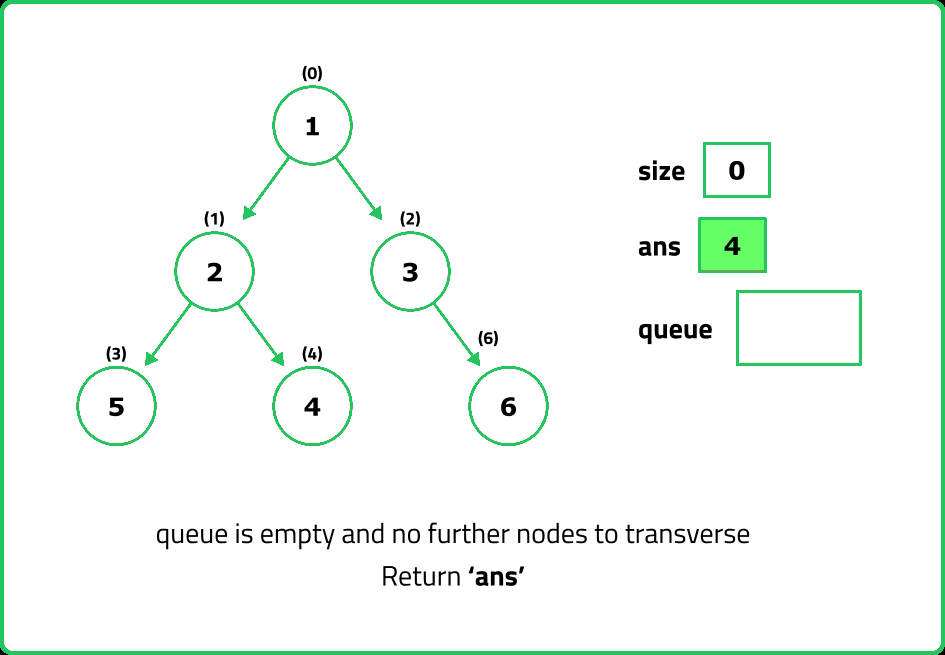123456789101112131415161718192021222324252627282930313233343536373839404142434445464748495051525354555657585960616263646566676869707172737475767778798081828384858687888990919293949596979899100101102103104105106107108109110111112113114115
#include <bits/stdc++.h>
using namespace std;
// Definition for a binary tree node.
struct TreeNode {
int data;
TreeNode *left;
TreeNode *right;
TreeNode(int val) : data(val), left(nullptr), right(nullptr) {}
};
class Solution {
public:
// Function widthOfBinaryTree to find the
// maximum width of the Binary Tree
int widthOfBinaryTree(TreeNode* root) {
// If the root is null,
// the width is zero
if (!root) {
return 0;
}
// Initialize a variable 'ans'
// to store the maximum width
int ans = 0;
// Create a queue to perform level-order
// traversal, where each element is a pair
// of TreeNode* and its position in the level
queue<pair<TreeNode*, int>> q;
// Push the root node and its
// position (0) into the queue
q.push({root, 0});
// Perform level-order traversal
while (!q.empty()) {
// Get the number of
// nodes at the current level
int size = q.size();
// Get the position of the front
// node in the current level
int mmin = q.front().second;
// Store the first and last positions
// of nodes in the current level
int first = 0, last = 0;
// Process each node
// in the current level
for (int i = 0; i < size; i++) {
// Calculate current position relative
// to the minimum position in the level
int cur_id = q.front().second - mmin;
// Get the current node
TreeNode* node = q.front().first;
// Pop the front node from the queue
q.pop();
// If this is the first node in the level,
// update the 'first' variable
if (i == 0) {
first = cur_id;
}
// If this is the last node in the level,
// update the 'last' variable
if (i == size - 1) {
last = cur_id;
}
// Enqueue the left child of the
// current node with its position
if (node->left) {
q.push({node->left, cur_id * 2 + 1});
}
// Enqueue the right child of the
// current node with its position
if (node->right) {
q.push({node->right, cur_id * 2 + 2});
}
}
// Update the maximum width by calculating
// the difference between the first and last
// positions, and adding 1
ans = max(ans, last - first + 1);
}
// Return the maximum
// width of the binary tree
return ans;
}
};
int main() {
TreeNode* root = new TreeNode(3);
root->left = new TreeNode(5);
root->right = new TreeNode(1);
root->left->left = new TreeNode(6);
root->left->right = new TreeNode(2);
root->right->left = new TreeNode(0);
root->right->right = new TreeNode(8);
root->left->right->left = new TreeNode(7);
root->left->right->right = new TreeNode(4);
Solution sol;
int maxWidth = sol.widthOfBinaryTree(root);
cout << "Maximum width of the binary tree is: " << maxWidth << endl;
return 0;
}
123456789101112131415161718192021222324252627282930313233343536373839404142434445464748495051525354555657585960616263646566676869707172737475767778798081828384858687888990919293949596979899100101102103104105106107108109110111112113
import java.util.LinkedList;
import java.util.Queue;
/**
* Definition for a binary tree node.
* public class TreeNode {
* int data;
* TreeNode left;
* TreeNode right;
* TreeNode(int val) { data = val; left = null, right = null; }
* }
**/
class Solution {
// Function widthOfBinaryTree to find the
// maximum width of the Binary Tree
public int widthOfBinaryTree(TreeNode root) {
// If the root is null,
// the width is zero
if (root == null) {
return 0;
}
// Initialize a variable 'ans'
// to store the maximum width
int ans = 0;
// Create a queue to perform level-order
// traversal, where each element is a pair
// of TreeNode* and its position in the level
Queue<Pair<TreeNode, Integer>> q = new LinkedList<>();
// Push the root node and its
// position (0) into the queue
q.offer(new Pair<>(root, 0));
// Perform level-order traversal
while (!q.isEmpty()) {
// Get the number of
// nodes at the current level
int size = q.size();
// Get the position of the front
// node in the current level
int mmin = q.peek().getValue();
// Store the first and last positions
// of nodes in the current level
int first = 0, last = 0;
// Process each node
// in the current level
for (int i = 0; i < size; i++) {
// Calculate current position relative
// to the minimum position in the level
int cur_id = q.peek().getValue() - mmin;
// Get the current node
TreeNode node = q.peek().getKey();
// Pop the front node from the queue
q.poll();
// If this is the first node in the level,
// update the 'first' variable
if (i == 0) {
first = cur_id;
}
// If this is the last node in the level,
// update the 'last' variable
if (i == size - 1) {
last = cur_id;
}
// Enqueue the left child of the
// current node with its position
if (node.left != null) {
q.offer(new Pair<>(node.left, cur_id * 2 + 1));
}
// Enqueue the right child of the
// current node with its position
if (node.right != null) {
q.offer(new Pair<>(node.right, cur_id * 2 + 2));
}
}
// Update the maximum width by calculating
// the difference between the first and last
// positions, and adding 1
ans = Math.max(ans, last - first + 1);
}
// Return the maximum
// width of the binary tree
return ans;
}
public static void main(String[] args) {
TreeNode root = new TreeNode(3);
root.left = new TreeNode(5);
root.right = new TreeNode(1);
root.left.left = new TreeNode(6);
root.left.right = new TreeNode(2);
root.right.left = new TreeNode(0);
root.right.right = new TreeNode(8);
root.left.right.left = new TreeNode(7);
root.left.right.right = new TreeNode(4);
Solution sol = new Solution();
int maxWidth = sol.widthOfBinaryTree(root);
System.out.println("Maximum width of the binary tree is: " + maxWidth);
}
}
12345678910111213141516171819202122232425262728293031323334353637383940414243444546474849505152535455565758596061626364656667686970717273747576777879808182838485868788899091929394959697
from collections import deque
# Definition for a binary tree node.
class TreeNode:
def __init__(self, val=0, left=None, right=None):
self.data = val
self.left = left
self.right = right
class Solution:
# Function widthOfBinaryTree to find the
# maximum width of the Binary Tree
def widthOfBinaryTree(self, root):
# If the root is null,
# the width is zero
if not root:
return 0
# Initialize a variable 'ans'
# to store the maximum width
ans = 0
# Create a queue to perform level-order
# traversal, where each element is a pair
# of TreeNode* and its position in the level
q = deque([(root, 0)])
# Perform level-order traversal
while q:
# Get the number of
# nodes at the current level
size = len(q)
# Get the position of the front
# node in the current level
mmin = q[0][1]
# Store the first and last positions
# of nodes in the current level
first = last = 0
# Process each node
# in the current level
for i in range(size):
# Calculate current position relative
# to the minimum position in the level
cur_id = q[0][1] - mmin
# Get the current node
node = q[0][0]
# Pop the front node from the queue
q.popleft()
# If this is the first node in the level,
# update the 'first' variable
if i == 0:
first = cur_id
# If this is the last node in the level,
# update the 'last' variable
if i == size - 1:
last = cur_id
# Enqueue the left child of the
# current node with its position
if node.left:
q.append((node.left, cur_id * 2 + 1))
# Enqueue the right child of the
# current node with its position
if node.right:
q.append((node.right, cur_id * 2 + 2))
# Update the maximum width by calculating
# the difference between the first and last
# positions, and adding 1
ans = max(ans, last - first + 1)
# Return the maximum
# width of the binary tree
return ans
if __name__ == "__main__":
root = TreeNode(3)
root.left = TreeNode(5)
root.right = TreeNode(1)
root.left.left = TreeNode(6)
root.left.right = TreeNode(2)
root.right.left = TreeNode(0)
root.right.right = TreeNode(8)
root.left.right.left = TreeNode(7)
root.left.right.right = TreeNode(4)
sol = Solution()
maxWidth = sol.widthOfBinaryTree(root)
print("Maximum width of the binary tree is:", maxWidth)
123456789101112131415161718192021222324252627282930313233343536373839404142434445464748495051525354555657585960616263646566676869707172737475767778798081828384858687888990919293949596979899100101102103104105106107
/**
* Definition for a binary tree node.
* class TreeNode {
* constructor(val = 0, left = null, right = null){
* this.data = val;
* this.left = left;
* this.right = right;
* }
* }
**/
class Solution {
// Function widthOfBinaryTree to find the
// maximum width of the Binary Tree
widthOfBinaryTree(root) {
// If the root is null,
// the width is zero
if (!root) {
return 0;
}
// Initialize a variable 'ans'
// to store the maximum width
let ans = 0;
// Create a queue to perform level-order
// traversal, where each element is a pair
// of TreeNode* and its position in the level
let q = [[root, 0]];
// Perform level-order traversal
while (q.length > 0) {
// Get the number of
// nodes at the current level
let size = q.length;
// Get the position of the front
// node in the current level
let mmin = q[0][1];
// Store the first and last positions
// of nodes in the current level
let first, last;
// Process each node
// in the current level
for (let i = 0; i < size; i++) {
// Calculate current position relative
// to the minimum position in the level
let cur_id = q[0][1] - mmin;
// Get the current node
let node = q[0][0];
// Pop the front node from the queue
q.shift();
// If this is the first node in the level,
// update the 'first' variable
if (i == 0) {
first = cur_id;
}
// If this is the last node in the level,
// update the 'last' variable
if (i == size - 1) {
last = cur_id;
}
// Enqueue the left child of the
// current node with its position
if (node.left) {
q.push([node.left, cur_id * 2 + 1]);
}
// Enqueue the right child of the
// current node with its position
if (node.right) {
q.push([node.right, cur_id * 2 + 2]);
}
}
// Update the maximum width by calculating
// the difference between the first and last
// positions, and adding 1
ans = Math.max(ans, last - first + 1);
}
// Return the maximum
// width of the binary tree
return ans;
}
}
// Example usage
let root = new TreeNode(3);
root.left = new TreeNode(5);
root.right = new TreeNode(1);
root.left.left = new TreeNode(6);
root.left.right = new TreeNode(2);
root.right.left = new TreeNode(0);
root.right.right = new TreeNode(8);
root.left.right.left = new TreeNode(7);
root.left.right.right = new TreeNode(4);
let sol = new Solution();
let maxWidth = sol.widthOfBinaryTree(root);
console.log("Maximum width of the binary tree is: " + maxWidth);


